Development of Inert, Polymer-Bonded Simulants for Explosives Detection Systems Based on Transmission X-ray
Abstract
1. Introduction
2. Results and Discussion
2.1. Characterisation of Explosives
2.2. Produced Simulants
2.3. Stability of Simulants
2.4. Measurement Uncertainty
2.5. Detection of Simulants Using EDS
2.6. Detection of Doped Simulants Using ETD
3. Materials and Methods
3.1. Software Modelling
3.2. Materials
3.3. Production Equipment
3.4. Production Process
3.5. Measurement Equipment
3.6. Calibration of Measurement Equipment
3.6.1. Reference Materials Approach
3.6.2. Experimental Design Approach
3.7. Repeatability and Intermediate Precision
4. Conclusions
Author Contributions
Funding
Conflicts of Interest
References
- The Government of Canada Response to the Commission of Inquiry into the Investigation of the Bombing of Air India Flight 182. Available online: https://www.publicsafety.gc.ca/cnt/rsrcs/pblctns/rspns-cmmssn/index-en.aspx (accessed on 12 November 2019).
- CIA. Terrorist Bombing of Pan Am Flight 103. Available online: https://www.cia.gov/about-cia/cia-museum/experience-the-collection/text-version/stories/terrorist-bombing-of-pan-am-flight-103.html (accessed on 12 November 2019).
- International Centre for Counter-Terrorism—Egypt’s Aviation Security since the Metrojet Bombing. Available online: https://icct.nl/publication/egypts-aviation-security-since-the-metrojet-bombing/ (accessed on 12 November 2019).
- OECD Economic Outlook 71 (2002)—Economic consequences of terrorism. Available online: http://www.oecd.org/economy/outlook/1935314.pdf (accessed on 23 October 2019).
- Spring 2019 Standard Eurobarometer (Annex). Available online: https://europa.eu/rapid/attachment/IP-19-4969/en/ANNEX-Spring%202019%20Standard%20Eurobarometer.pdf (accessed on 23 October 2019).
- Regulation (EC) No 300/2008 of the European Parliament and of the Council of 11 March 2008 on common rules in the field of civil aviation security and repealing Regulation (EC) No 2320/2002 (Text with EEA relevance). Available online: https://eur-lex.europa.eu/legal-content/EN/ALL/?uri=CELEX:32008R0300 (accessed on 23 October 2019).
- European Commission. Aviation security—Legislation. Available online: https://ec.europa.eu/transport/modes/air/security/legislation_en (accessed on 23 October 2019).
- Commission Implementing Regulation (EU) 2015/1998 of 5 November 2015 laying down detailed measures for the implementation of the common basic standards on aviation security (Text with EEA relevance). Available online: https://eur-lex.europa.eu/legal-content/EN/TXT/?uri=CELEX:32015R1998 (accessed on 23 October 2019).
- Runkle, R.C.; White, T.A.; Miller, E.A.; Caggiano, J.A.; Collins, B.A. Photon and neutron interrogation techniques for chemical explosives detection in air cargo: A critical review. Nucl. Instrum. Methods Phys. Res. 2009, 603, 510–528. [Google Scholar] [CrossRef]
- Singh, S.; Singh, M. Explosives detection systems (EDS) for aviation security. Signal Process. 2003, 83, 31–55. [Google Scholar] [CrossRef]
- Wells, K.; Bradley, D.A. A review of X-ray explosives detection techniques for checked baggage. Appl. Radiat. Isot. 2012, 70, 1729–1746. [Google Scholar] [CrossRef] [PubMed]
- ECAC Common Evaluation Process of Security Equipment. Available online: https://www.ecac-ceac.org/cep-main (accessed on 23 October 2019).
- Transportation Security Laboratory. Available online: https://www.dhs.gov/science-and-technology/transportation-security-laboratory (accessed on 23 October 2019).
- Wartman, A.; Koffler, B.B. Mouldable Plastic Explosives and Inert Simulants for Mouldable Plastic Explosives. U.S. Patent 7,854,811, 21 December 2010. [Google Scholar]
- Duffy, S.F.; Goettler, S.J., III; Krauss, R.A. Inert and Non-Toxic Explosive Simulants and Method of Production. U.S. Patent 8,563,316, 22 October 2013. [Google Scholar]
- Kury, J.W.; Anderson, B.L. Explosive Simulants for Testing Explosive Detection Systems. U.S. Patent 5,958,299, 28 September 1999. [Google Scholar]
- DSA Detection—Inert Explosives. Available online: https://www.dsadetection.com/ied-threat-training-aids/threat-training-aids/ied-devices/inert-explosives.html (accessed on 23 October 2019).
- A.I. Explosives—Plastic Bonded Explosives Simulants. Available online: http://www.aiexplosives.com/explosives_products.asp?ProjectID=24 (accessed on 23 October 2019).
- Renful—Individual Simulant Threats. Available online: https://renful.co.uk/individual-simulant-threats (accessed on 23 October 2019).
- Faust, A.A.; Nacson, S.; Koffler, B.; Bourbeau, E.; Gagne, L.; Laing, R.; Anderson, C.J. Design and validation of inert homemade explosive simulants for X-ray-based inspection systems. In Proceedings of the Chemical, Biological, Radiological, Nuclear, and Explosives (CBRNE) Sensing XV, Baltimore, MD, USA, 5–9 May 2014; Volume 90730. [Google Scholar]
- Bonnin, A.; Duvauchelle, P.; Kaftandjian, V.; Ponard, P. Concept of effective atomic number and effective mass density in dual-energy X-ray computed tomography. Nucl. Instrum. Methods Phys. Res. 2014, 318, 223–231. [Google Scholar]
- Bureau International des Poids et Mesures, Evaluation of measurement data—Guide to the expression of uncertainty in measurement JCGM 100:2008. Available online: https://www.bipm.org/en/publications/guides/gum.html (accessed on 21 October 2019).
- Smith, J.A.; Martz, H.E.; Kallman, J.S. Case for an Improved Effective-Atomic Number for the Electronic Baggage Scanning Program; LLNL-TR-520312; Lawrence Livermore National Laboratory: Livermore, CA, USA, 2011. [Google Scholar]
- Bond, K.C.; Smiths, J.A.; Treuer, J.N.; Azevedo, S.G.; Kallman, J.S.; Martz, H.E. ZeCalc Algorithm Details; LLNL-TR-609327; Lawrence Livermore National Laboratory: Livermore, CA, USA, 2013. [Google Scholar]
- Anderson, D. Calculation of Effective Atomic Number, Ze, for the Production of Explosives Simulants for X-ray Screening Equipment; JRC Technical Report 100571 for European Commission Joint Research Centre: Geel, Belgium, June 2016. [Google Scholar]
Sample Availability: Simulants will be made available to EU Member States’ appropriate authorities for aviation security. |
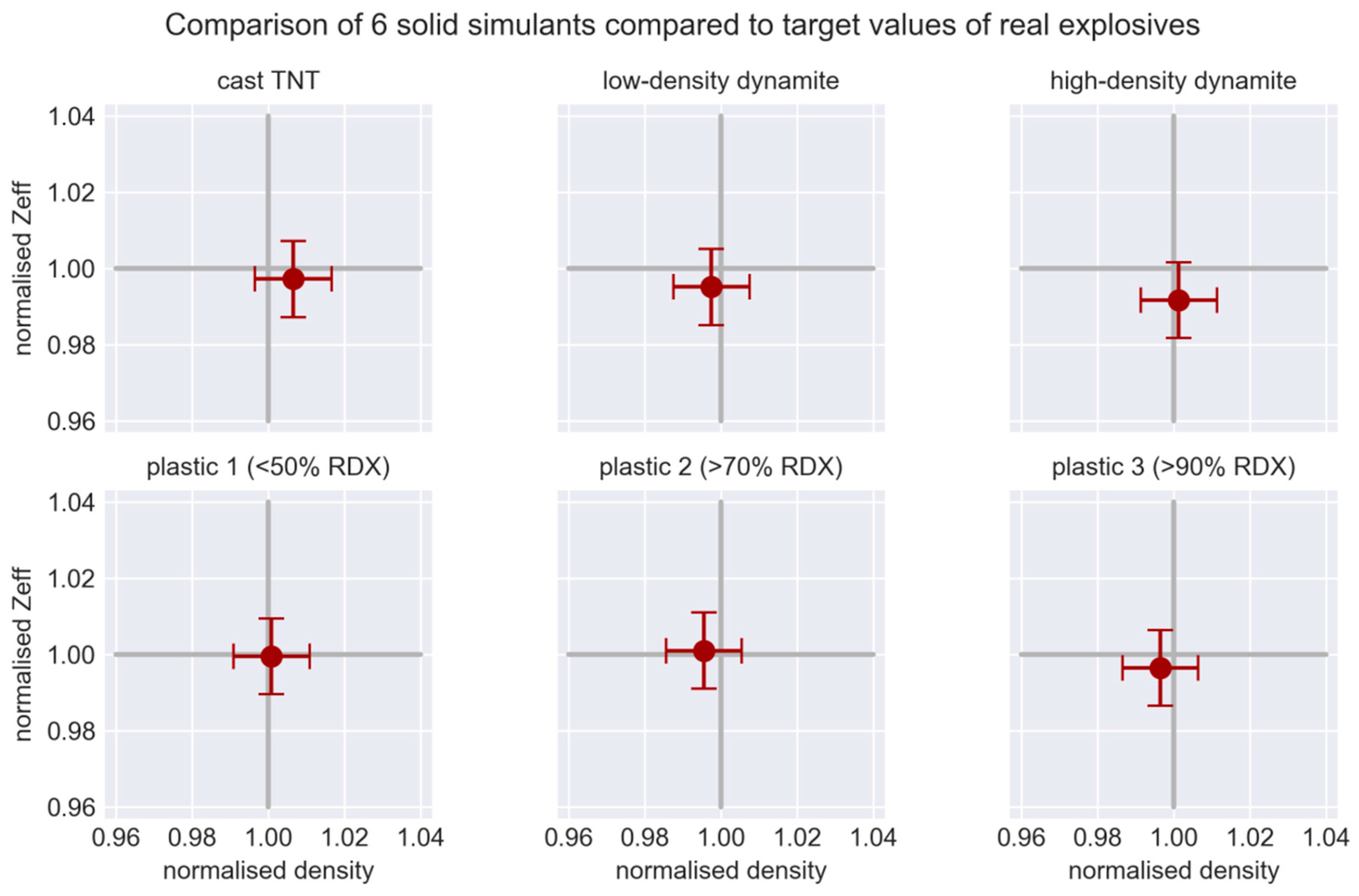

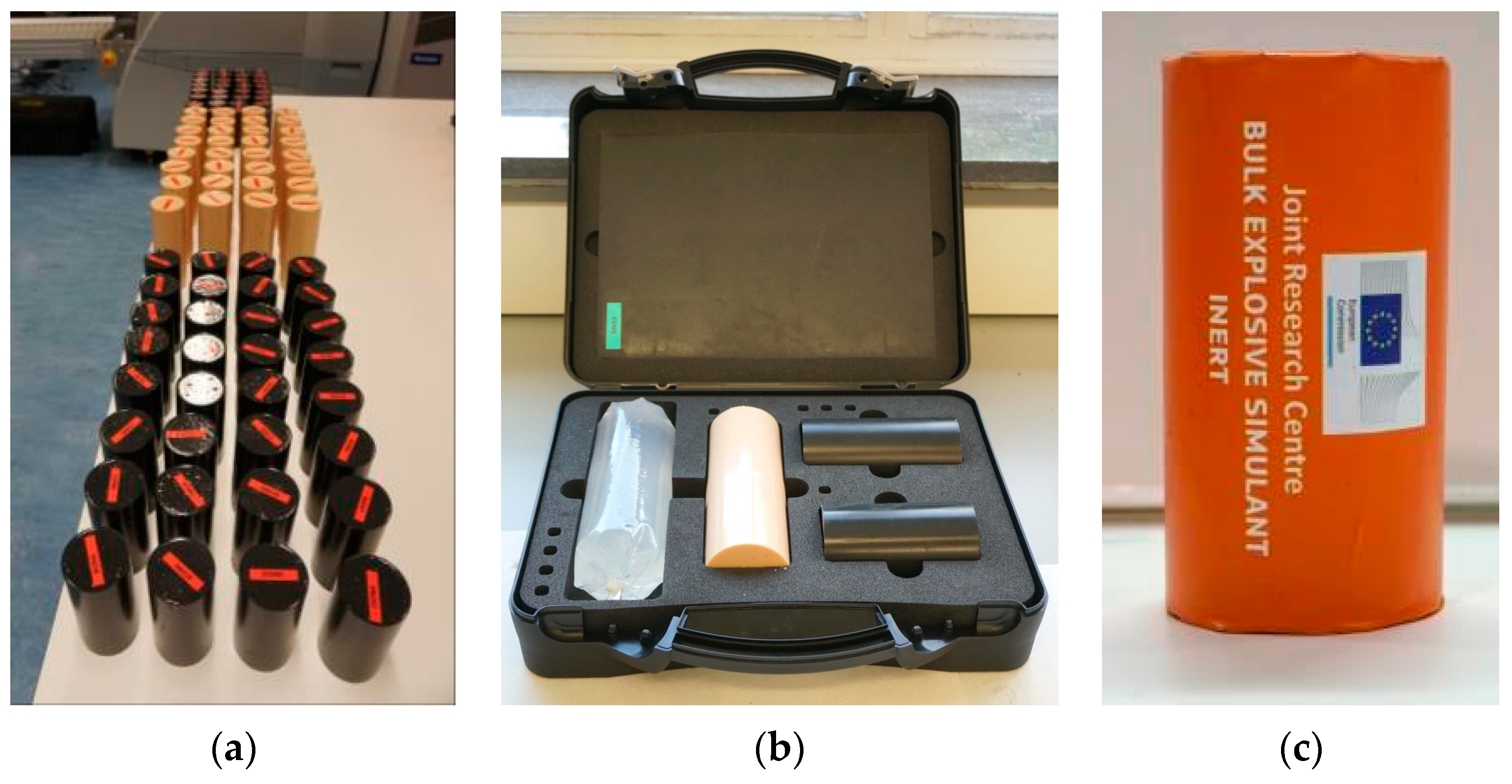
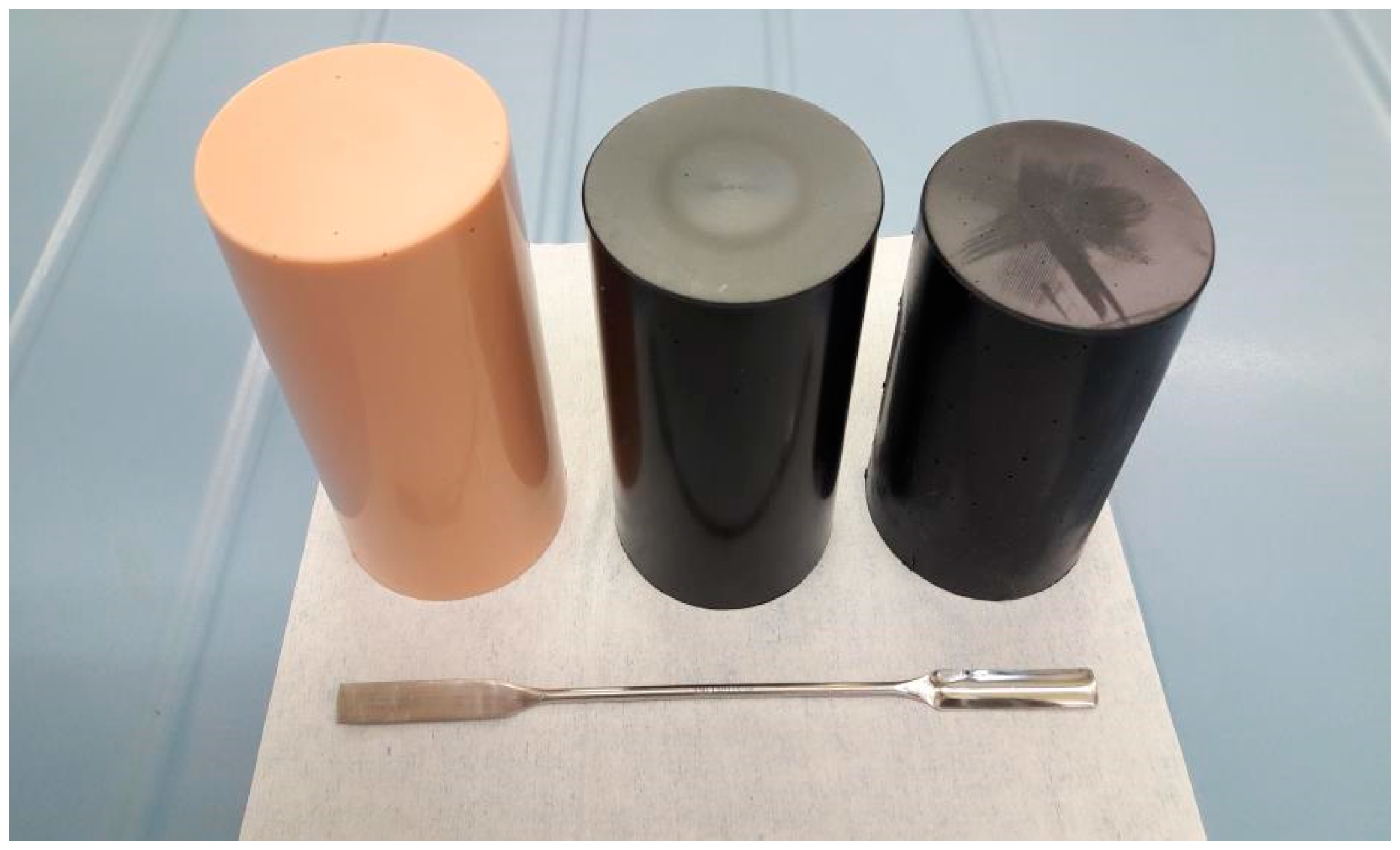
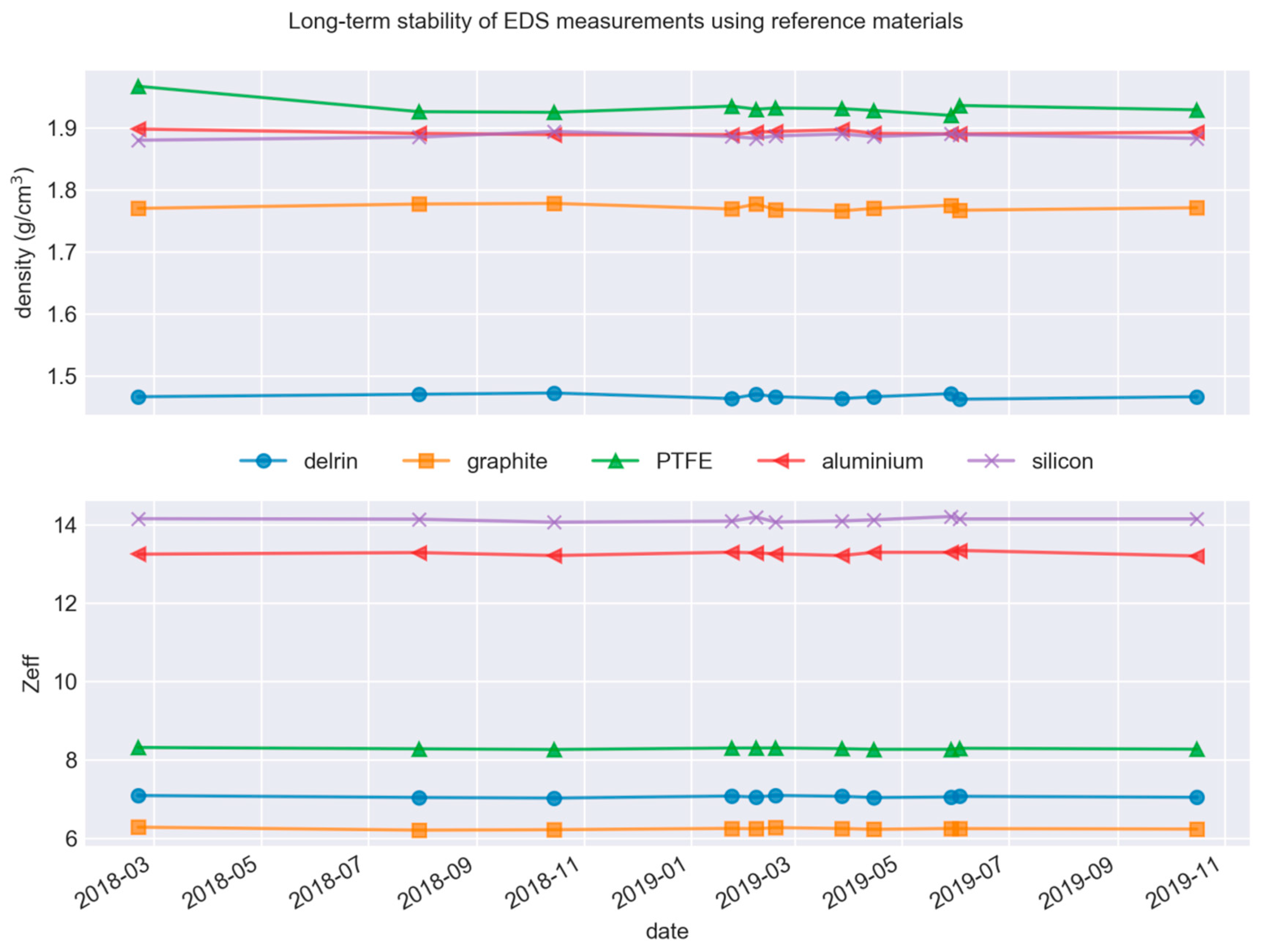


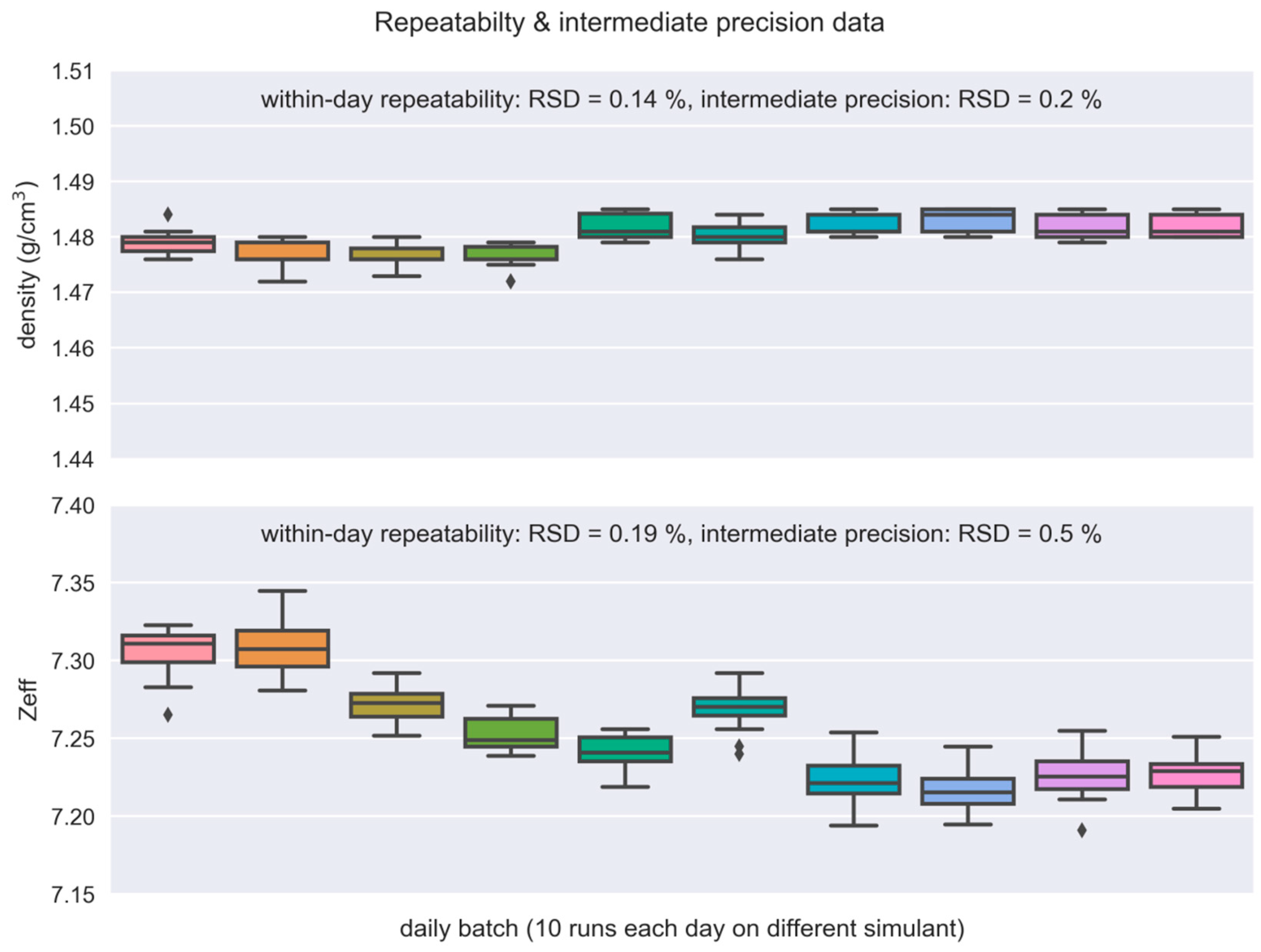
| Equipment 1 | SN59 | SN60 | SN62 | SN64 | SN67 | SN69 |
|---|---|---|---|---|---|---|
| EDS 1 | 20/20 | 20/20 | 20/20 | 20/20 | 20/20 | 20/20 |
| EDS 2 | 20/25 | 23/25 | 16/25 | 20/20 | 20/20 | 20/20 |
| EDS 3 | 20/20 | 20/20 | 12/20 | 16/20 | 20/20 | 20/20 |
| EDS 4 | 20/20 | 20/20 | 20/20 | 10/10 | 10/10 | 10/10 |
| EDS 5 | 20/20 | 19/20 | 19/20 | 20/20 | 20/20 | 20/20 |
| EDS 6 | 10/10 | 10/10 | 8/10 | 10/10 | 10/10 | 10/10 |
| EDS 7 | 20/20 | 20/20 | 20/20 | 20/20 | 20/20 | 20/20 |
| EDS 8 | 20/20 | 20/20 | 3/20 | 20/20 | 17/20 | 20/20 |
| EDS 9 | 10/10 | 10/10 | 10/10 | 10/10 | 10/10 | 10/10 |
| Doped Simulant | ETD 1 1 | ETD 2 | ETD 3 | ETD 4 | ETD 5 |
|---|---|---|---|---|---|
| PETN in ‘PETN’ simulant | 6/6 | 6/6 | 4/6 | 6/6 | 3/6 |
| RDX in ‘SEMTEX-H’ simulant | 6/6 | 6/6 | 6/6 | 6/6 | 6/6 |
| EGDN in ‘commercial dynamite’ simulant | 4/6 | 0/6 | 0/6 | 0/6 | 2/6 |
| Simulant | Binder | B4C | Al2O3 |
|---|---|---|---|
| SN-43 | 48.0% | 44.8% | 7.2% |
| SN-44 | 37.7% | 54.7% | 7.5% |
| SN-45 | 60.7% | 32.6% | 6.7% |
| SN-46 | 50.9% | 30.5% | 18.5% |
| SN-47 | 63.5% | 18.2% | 18.3% |
| SN-48 | 40.6% | 40.7% | 18.7% |
| SN-50 | 38.9% | 48.9% | 12.1% |
| SN-51 | 61.8% | 26.6% | 11.6% |
| SN-52 | 49.2% | 38.9% | 11.9% |
| Nuctech Kylin | Smiths XCT | |||
|---|---|---|---|---|
| Density | Zeff | Density | Zeff | |
| Equation | z = z0 + a·x + b·y + c·x2 + d·y2 + f·x·y | |||
| Z0 | 1.14036 | 6.92839 | 1.02539 | 7.35118 |
| a | 0.24857 | −1.7336 | 0.29455 | −1.57553 |
| b | 0.2946 | 9.77275 | 0.63816 | 4.4915 |
| c | 0.73168 | 0.81162 | 0.59796 | 0.25238 |
| d | 1.24272 | −19.0843 | 0.75723 | 0.22944 |
| f | 1.82343 | 5.00551 | 1.68086 | 6.25114 |
| Adj. R-Square | 0.9999 | 0.99847 | 0.99996 | 0.99499 |
© 2019 by the authors. Licensee MDPI, Basel, Switzerland. This article is an open access article distributed under the terms and conditions of the Creative Commons Attribution (CC BY) license (http://creativecommons.org/licenses/by/4.0/).
Share and Cite
Vahčič, M.; Anderson, D.; Ruiz Osés, M.; Rarata, G.; Diaconu, G. Development of Inert, Polymer-Bonded Simulants for Explosives Detection Systems Based on Transmission X-ray. Molecules 2019, 24, 4330. https://doi.org/10.3390/molecules24234330
Vahčič M, Anderson D, Ruiz Osés M, Rarata G, Diaconu G. Development of Inert, Polymer-Bonded Simulants for Explosives Detection Systems Based on Transmission X-ray. Molecules. 2019; 24(23):4330. https://doi.org/10.3390/molecules24234330
Chicago/Turabian StyleVahčič, Mitja, David Anderson, Miguel Ruiz Osés, Grzegorz Rarata, and Gabriela Diaconu. 2019. "Development of Inert, Polymer-Bonded Simulants for Explosives Detection Systems Based on Transmission X-ray" Molecules 24, no. 23: 4330. https://doi.org/10.3390/molecules24234330
APA StyleVahčič, M., Anderson, D., Ruiz Osés, M., Rarata, G., & Diaconu, G. (2019). Development of Inert, Polymer-Bonded Simulants for Explosives Detection Systems Based on Transmission X-ray. Molecules, 24(23), 4330. https://doi.org/10.3390/molecules24234330






